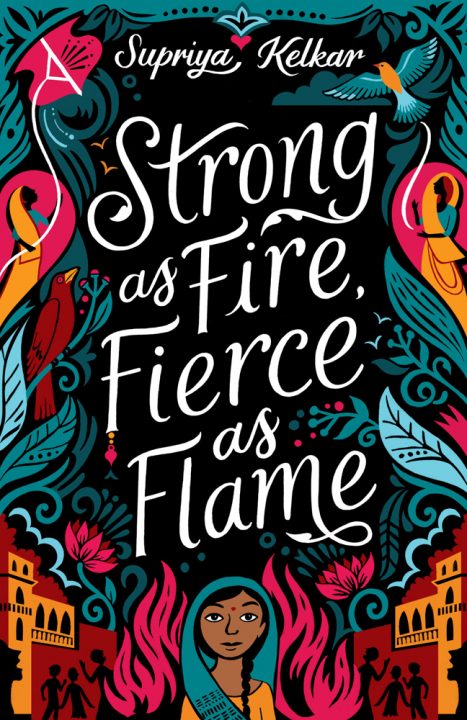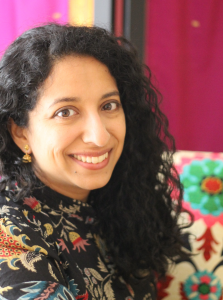
STRONG AS FIRE, FIERCE AS FLAME
India, 1857
Meera’s future has been planned for her for as long as she can remember. As a child, her parents married her to a boy from a neighboring village whom she barely knows. But on the eve of her thirteenth birthday, her husband is killed in the riots following an uprising of Indian soldiers. Meera’s father insists that she follow the dictates of their fringe religious sect: end her own life on her husband’s funeral pyre.
Risking everything, Meera runs away, escaping into the chaos of the rebellion. But her newfound freedom is short-lived,
India, 1857
Meera’s future has been planned for her for as long as she can remember. As a child, her parents married her to a boy from a neighboring village whom she barely knows. But on the eve of her thirteenth birthday, her husband is killed in the riots following an uprising of Indian soldiers. Meera’s father insists that she follow the dictates of their fringe religious sect: end her own life on her husband’s funeral pyre.
Risking everything, Meera runs away, escaping into the chaos of the rebellion. But her newfound freedom is short-lived, as she is forced to become a servant in the house of a high-ranking British East India Company captain. Through her work, she gains confidence, new friends, and new skills. But one day, Meera stumbles upon the captain’s secret stock of ammunition, destined to be used by the British to continue colonizing India and control its citizens.
Will Meera do her part to take down the British colonists and alert the rebellion of the stockpile? Or will she stay safe and let others make decisions for her? How much fire must a girl face to finally write her own destiny?
- Lee & Low Books
- Hardcover
- February 2021
- 324 Pages
- 9781643790404
About Supriya Kelkar
 Supriya Kelkar grew up in the Midwest, where she learned Hindi as a child by watching three Hindi movies a week. Winner of the New Visions Award for Ahimsa, Supriya is a screenwriter who has worked on the writing teams for several Hindi films and one Hollywood feature. Supriya’s books include Ahimsa; Strong as Fire, Fierce as Flame; American as Paneer Pie; and That Thing About Bollywood, among others.
Supriya Kelkar grew up in the Midwest, where she learned Hindi as a child by watching three Hindi movies a week. Winner of the New Visions Award for Ahimsa, Supriya is a screenwriter who has worked on the writing teams for several Hindi films and one Hollywood feature. Supriya’s books include Ahimsa; Strong as Fire, Fierce as Flame; American as Paneer Pie; and That Thing About Bollywood, among others.
Praise
“Child marriages, sexist ideologies, and the terrors of colonialism are just a handful of subjects Kelkar scrutinizes through the lens of a teenager in the thick of it. Meera’s transformation from a complacent girl to embracing her spirited convictions is nothing short of inspiring.” —Booklist
“[L]aced with twists, turns, and reveals that are both surprising and riveting. . . . An absorbing story about a strong girl living during tumultuous times.” —Kirkus Reviews
Discussion Questions
1. The first lines of the book are “My father taught the village boys right outside our little earthen home, but I wasn’t a boy, so I didn’t get to learn. That didn’t stop me from trying, though.” What do these lines tell us about how things are in Meera’s life? What do they tell us about Meera’s character?
2. To “other” someone is to treat or think of a person or a group of people as alien to oneself or one’s group. What are some examples of othering in the book?
3. Meera has a very complicated relationship with Memsahib. In what ways does Meera find comfort in Memsahib? How does Meera’s thinking change when she realizes what Memsahib really thinks of the South Asian people whose land she is colonizing?
4. Meera cares deeply about the caged koel, Lal, at the Keenes’ bungalow. What do you think Meera feels when Lal flies away from his cage? How do you think he has changed her?
5. What are Meera and Bhavani’s strengths and weaknesses? How does Meera’s friendship with Bhavani challenge her? How does it change her over the course of the story?
6. What do you think the title, “Strong as Fire, Fierce as Flame” means?
7. How does Meera feel about her sister-in-law, Sheela, when she first sees her? How does Meera feel when she first runs into Sheela at the market in Indranagar? How is that different from Meera’s interaction with Sheela the next time they meet at the market?
8. What does Ravi’s kite mean to Meera? How do you think she feels when she flies it?
9. What does the word “decolonize” mean to you?
10. Why do you think the author chose to include such a detailed historical note at the end of the book?
11. Look at the cover. What symbolism do you see there?
Video
Essay
Author’s Note from Supriya Kelkar
Strong as Fire, Fierce as Flame is the fictional account of one girl’s experiences during a volatile period of injustice, racism, sexism, and deep unrest in history. I hope readers understand the gravity of the situation and know that no actions with fire or dangerous materials should ever be taken without adult supervision.
While this story, its characters, and the North Indian villages and town it takes place in are fictional, several of the concepts and incidents mentioned are based on historical events. But with so few middle grade historical novels set in South Asia in publication today, it is sometimes easy to assume everything in this book was the standard for everyone there in 1857. In reality, that is far from the truth, as the South Asian region is full of diverse cultures, religions, languages, and traditions.
The diverse stories and experiences that took place in the South Asian region during the time of European colonialism have often been overlooked in books published years ago that many readers still treasure today as classics. I remember being shocked in elementary school when I read The Secret Garden and recognized that part of the story took place in India. Growing up, I had never read a book that wasn’t from India that had Indian characters in it. I immediately felt a deep sense of pride and a connection to the book. But as I read more, I couldn’t shake this uncomfortable feeling that the book did not think highly of Indian people. They were in the background. The story was Mary’s even when it took place in India. Indians were described as “not people” but “servants who must salaam to you.” I was overcome with a feeling of embarrassment and deep shame. Books like The Secret Garden and work by Rudyard Kipling, like The Jungle Book, are just a few examples of how racist many “classics” from this time period can be. Native people are viewed through a colonial gaze. Their lands serve as exotic, thrilling backdrops to stories, but their people are rarely even treated like people. Their stories are in the background, unseen, forgotten, not important enough to be told on the page, while the colonizers’ stories are prioritized.
When the inherent racism in these stories is pointed out, the idea is sometimes met with pushback. Excuses are made, saying it doesn’t matter if someone finds something racist in these stories, because these books were written a long time ago, and that’s just the way people thought back then. But that isn’t the way everyone thought back then. That excuse is once again only thinking about the people colonizing, not the people whose lives were forever changed from being colonized.
I was inspired, in part, to write Strong as Fire, Fierce as Flame to challenge these notions. I wanted to tell the stories that weren’t considered important, because they are important, and they shouldn’t be hidden or overlooked. I peppered this book with several real-life incidents I found in my research to paint a more accurate portrait of what was going on in lands and nations where colonial powers had taken over.
The journals and diaries the British memsahibs write in this story are based on real journals and travel books. I based Memsahib’s observation of the British dancing in the Taj Mahal on an excerpt
from Fanny Parkes’s writing. She was a memsahib who spoke fluent Hindi and described British ladies and gentlemen having a band play on the marble terrace of the Taj Mahal, as they danced “quadrilles in front of the tomb.” Travel books written by memsahibs in India were widely read and passed around in the United Kingdom. They were one of the main ways people in the UK learned about the European experience in India. These books were many times filled with derogatory, racist observations, including the animal1 Memsahib compares Meera to. They used words like indolent, cunning, devious, scum, and servile to describe the Indian population whose land they had invaded. They pointed out problems in the land they were in without acknowledging their colonial interference was also a problem. And they viewed the traditions, cultures, and religions of India through a prejudiced, colonial gaze, in which the native ways were looked down upon, ridiculed, and considered backward or morally inferior.
According to author and historian William Darlymple, during the Victorian era, much of British colonial history was rewritten to take out the looting and plundering and reframe the brutality as an exchange of ideas, art, and railways from the West to the East.2
The toast Captain Keene gives “to the corpse of India” is one I borrowed from not a memsahib but the British governor-general of Bengal, Lord Wellesley, who said it in one of his toasts. The story the collector tells about buying an Indian baby for a few coins is also a true story from the early 1800s, as was the remark the collector makes, referring to Indian children as “swarms of little, naked bronze children,” a quote which came from a magistrate stationed at Meerut.
I thought these true stories and quotes were necessary to accurately portray a colonizer’s mindset, since many journals and books have been published glorifying colonialism.
In reality, colonialism was a vicious, cruel, racist practice that led to the deaths of millions of people around the world, and whose effects continue to be seen today. I hope this book serves as a reminder of what the experience of colonialism was for those who were colonized.
I hope this book tells just one small part of a much bigger story that has largely been erased in our lifetime. And I hope this book encourages readers to question who is being centered in colonial stories and in all stories, to find out who is telling the story, and to remember who is being left out.
Because that matters.
